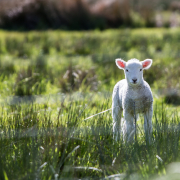Grazing Solar Sites Provides Benefits to Land and Farmers
By Heidi Kolbeck-Urlacher, Senior Policy Associate, Center for Rural Affairs
On a chilly September afternoon, a flock of Targhee/Rambouillet cross sheep quietly wander the grounds of an 18-acre solar garden site in southwestern Minnesota. The sheep are fulfilling a duty known as solar grazing, which uses livestock to manage vegetation at solar sites.
Replacing traditional mowing, solar grazing offers numerous environmental and financial benefits.
“Environmentally, you’re allowing a diverse plant community to grow, which increases soil health over time, reduces erosion, and increases pollinator habitat,” said Audrey Lomax, manager of the solar grazing program at Minnesota Native Landscapes. “Economically, farmers can supplement their income and grow their business, and developers see a cost savings as they spend less over time to manage the sites.”
The rapid growth of the solar energy industry means more acres of land will be needed to host these projects.
“Whether people like solar or not, it’s a rapidly growing reality, and the land that is used must be managed,” said Trent Hendricks, who operates Cabriejo Ranch in West Plains, Missouri, and provides regenerative grazing services to utility-scale solar farms. “Grazing provides numerous benefits that can’t be realized through paving or mowing. This includes carbon sequestration, increasing biodiversity, providing habitat for wildlife like ground-nesting birds, and keeping land in agricultural use by supporting lamb production.”
The sheep at the site are owned by Matt Brehmer, a beginning farmer from Brookings, South Dakota. Matt recently bought a farm and purchased livestock a year ago. His pasture won’t support both cows and sheep, so working as a solar grazier gives him additional pasture opportunities and helps support his business.
“I heard about solar grazing from another farmer who was doing it,” Matt said. “After trying it for a season, I plan to do it again and would recommend it to others.”
Audrey said solar grazing is something more farmers should consider.
“This is a high-value service that can allow farmers to grow their business, and even their flock, without land,” she said. “This is especially true for beginning farmers who often don’t have infrastructural support or access to land.”
As the solar industry continues to grow, practices like solar grazing can play an important role in ensuring clean energy, environmental, and agricultural goals can be achieved together. Some states, such as Massachusetts and New Jersey, have created policies to incentivize the dual-use of solar with agriculture.
“If we are going to promote solar as an energy solution, we have a responsibility to also ensure good land management,” Trent said. “With grazing, we can keep animals on the land and keep it in food production.”



